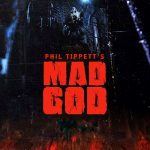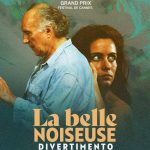Goodfellas (1990)

Overview:
Martin Scorsese’s “Goodfellas” is an electrifying cinematic journey through the gritty underworld of the Mafia, chronicling the rise and fall of Henry Hill, a real-life mob associate. Adapted from Nicholas Pileggi’s non-fiction book Wiseguy, this film transcends the traditional gangster movie formula, blending dark humor, intense drama, and brutal violence with sharp narrative insight. Goodfellas masterfully balances the allure and glamour of organized crime with the inevitable moral and personal decline of its protagonists, solidifying its reputation as one of the greatest films of all time and a high-water mark in the gangster genres
Suggested videos for you:
Plot:
The movie follows the life of Henry Hill (Ray Liotta) from his early days as a young boy in 1950s Brooklyn who idolizes the local Mafia, to his initiation into the world of organized crime. Henry’s voice-over narration leads the audience through his life, starting from his youthful fascination with the mobsters who controlled his neighborhood, to his first steps into their world when he begins working for Paulie Cicero (Paul Sorvino), the local crime boss.
Henry quickly becomes a part of the inner circle, forming close bonds with the violent and unpredictable Tommy DeVito (Joe Pesci) and the seasoned, pragmatic Jimmy Conway (Robert De Niro). Together, they commit a series of crimes, ranging from hijackings to multimillion-dollar heists, including the infamous Lufthansa robbery. As the years progress, Henry enjoys the luxurious lifestyle that comes with being a “wiseguy”—money, cars, women, and respect.
However, the darker side of mob life gradually emerges. The constant threat of violence, both from outside enemies and from within the organization, looms over every interaction. Tommy’s brutal murder of a made man sets off a series of dangerous repercussions. As Henry becomes more deeply involved in the drug trade, against the wishes of his boss Paulie, his life starts to spiral out of control. His cocaine addiction, paranoia, and reckless behavior bring him to the brink, leading to his arrest and eventual decision to turn informant, betraying his former friends in order to escape death or life in prison.
The film ends with Henry entering the Witness Protection Program, lamenting the loss of the mob life he once idolized, now reduced to a “nobody,” living a quiet and anonymous life.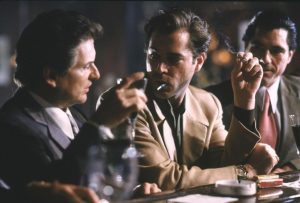
Themes:
Goodfellas is primarily concerned with the allure of power, wealth, and respect, and how these forces shape the lives of its characters. For Henry Hill, the Mafia represents an escape from a mundane, working-class existence into a life of excitement and privilege. Scorsese explores how the mob operates on a code of loyalty, violence, and business-like efficiency, yet the film gradually reveals the hollowness at the core of this lifestyle.
One of the central themes is the fragility of loyalty in the mob world. While Henry, Jimmy, and Tommy initially seem inseparable, bound by their shared experiences and success, their relationships are transactional and driven by self-interest. This is most clearly seen when Henry turns informant—his ultimate betrayal of the family he once revered. Loyalty, Scorsese argues, is an illusion in a world driven by greed and survival instincts.
The film also grapples with the dichotomy between the glamour of mob life and its inherent violence and chaos. In scenes like the famous Copacabana tracking shot, where Henry takes Karen (Lorraine Bracco) through the back entrance of the club, we see the intoxicating allure of the mob’s power and influence. But these moments are counterbalanced by shocking scenes of violence, such as Tommy’s murder of Billy Batts or the aftermath of the Lufthansa heist, where associates are killed to cover Jimmy’s tracks. Scorsese juxtaposes the exhilarating highs of mob life with its brutal, often bloody consequences.
Another key theme is the seductive pull of materialism and excess. As Henry rises in the ranks, his life becomes defined by conspicuous consumption—expensive clothes, lavish homes, luxury cars. Yet, the more he accumulates, the more unstable his life becomes. By the film’s end, Henry is consumed by paranoia and drug addiction, a stark contrast to the confident, ambitious young man we meet at the beginning.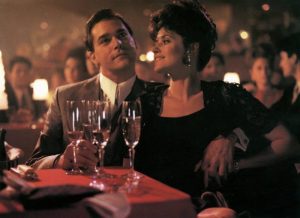
Direction & Cinematography:
Martin Scorsese’s direction in Goodfellas is nothing short of masterful. His kinetic style matches the frenetic energy of Henry’s life, with the film’s pace never letting up as it mirrors the rush and tension of the characters’ world. Scorsese’s use of long takes, most notably the iconic Copacabana nightclub scene, immerses the viewer in the experience of mob life, offering a fluid and unbroken perspective on the luxury and influence Henry has acquired.
The film is also notable for its frenetic, rapid-fire editing, courtesy of Thelma Schoonmaker, which brings a sense of chaos and urgency, particularly in the final act, when Henry’s world is collapsing under the weight of his paranoia and drug abuse. The montage set to the Rolling Stones’ “Monkey Man,” showing Henry’s frantic day of drug running and evading police surveillance, is a perfect encapsulation of the film’s ability to blend high-energy filmmaking with narrative tension.
The cinematography by Michael Ballhaus is equally impressive, capturing both the dark, claustrophobic interiors of mob hangouts and the bright, almost dream-like quality of the wealth and excess that define much of Henry’s life.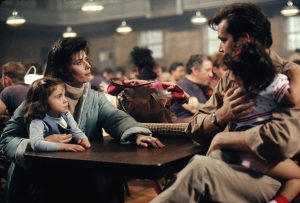
Performances:
The cast of Goodfellas delivers unforgettable performances, each actor bringing depth and intensity to their roles. Ray Liotta anchors the film with his portrayal of Henry Hill, capturing both the character’s early naivety and his later descent into paranoia and desperation. Liotta’s performance is complex, blending charm and menace, making Henry a sympathetic character even as his actions become increasingly self-destructive.
Robert De Niro’s Jimmy Conway is a figure of quiet menace, a calm but ruthless criminal who values loyalty—until it becomes inconvenient. De Niro imbues Jimmy with an air of authority, but also unpredictability, especially in the film’s final act when he begins eliminating anyone who could implicate him in the Lufthansa heist.
Joe Pesci’s performance as Tommy DeVito is legendary, earning him an Academy Award for Best Supporting Actor. Pesci’s Tommy is a volatile and terrifying figure, capable of turning from humor to homicidal rage in an instant, as seen in the famous “funny how?” scene. His unpredictability drives much of the tension in the film, and his eventual demise serves as a chilling reminder of the mob’s brutal code of conduct.
Lorraine Bracco is equally impressive as Karen Hill, Henry’s wife, whose perspective provides a grounding counterpoint to the male-dominated mob world. Her performance captures Karen’s initial attraction to Henry’s dangerous lifestyle, followed by her growing disillusionment and fear as his criminal life spirals out of control.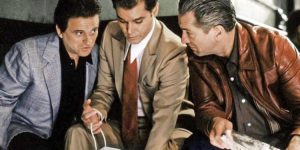
Legacy and Reception:
Upon its release in 1990, Goodfellas was met with universal acclaim and has since been hailed as one of the greatest films ever made. It received six Academy Award nominations, with Pesci winning for Best Supporting Actor. While it lost Best Picture to Dances with Wolves, its influence on filmmaking and popular culture has been immense. Goodfellas redefined the gangster genre, offering a more realistic and nuanced depiction of organized crime than had been seen before.
Scorsese’s stylistic innovations, coupled with the film’s unflinching portrayal of violence and moral decay, influenced a generation of filmmakers and spawned numerous imitators. Films and television shows like The Sopranos owe a great debt to Goodfellas, and its status as a cultural touchstone remains intact decades after its release.
Final Thoughts:
Goodfellas is not just a great gangster movie; it is a profound exploration of ambition, morality, and the human desire for power and respect. Martin Scorsese’s masterful direction, combined with unforgettable performances from its cast, creates a film that is exhilarating, shocking, and emotionally resonant. With its rapid pacing, immersive storytelling, and unflinching depiction of the mob’s violent world, Goodfellas remains a towering achievement in cinema, offering a gripping, multifaceted view of the American underworld that continues to captivate audiences.



